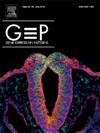MDK生长因子在梅花鹿鹿角发育中的意义:深入分析。
IF 1.1
4区 生物学
Q4 DEVELOPMENTAL BIOLOGY
引用次数: 0
摘要
鹿茸期鹿角生长迅速。midkine (MDK)作为一种重要的动物内源性生长因子,可能与鹿角的生长密切相关。然而,MDK在丝绒期的时空表达模式尚不清楚。本研究通过分析MDK在梅花鹿鹿角生长过程中的分子特征和时空表达动态,探讨MDK在梅花鹿鹿角生长过程中的生理作用。该研究克隆了MDK的编码序列(CDS),全长429 bp,编码142个氨基酸。生物信息学预测分析结果表明,MDK是一种细胞外亲水分泌蛋白,主要由随机线圈组成。MDK蛋白在进化中相对保守,梅花鹿MDK蛋白与反刍动物亲缘关系最近,与鸟类亲缘关系最远。从鹿角早期、EP、EP三个重要生长发育节点采集鹿角尖端组织(真皮、间质、软骨)。中期,MP。采用实时定量聚合酶链反应(qRT-PCR)检测MDK的时空表达。结果表明,MDK在鹿角尖EP、MP、LP的所有组织位点均有表达。MDK在各生长时期表达模式一致,在真皮和软骨中表达强烈。MDK的表达在不稳定状态下持续上调,而在其他组织中呈先上调后下调的趋势,且与EP和LP相比,MDK在MP中的表达非常显著(P本文章由计算机程序翻译,如有差异,请以英文原文为准。
The significance of MDK growth factor in the antler development of sika deer (Cervus nippon): An in-depth analysis
Deer antlers exhibit rapid growth during the velvet phase. As a critical endogenous growth factor in animals, midkine (MDK) is likely closely associated with the growth of antlers. However, the spatio-temporal expression pattern of MDK during the velvet phase was unclear. This study explored the physiological role of MDK by analyzing its molecular characterization and spatio-temporal expression dynamics during the growth of sika deer antlers. The study cloned the coding sequences (CDS) of MDK, which spanned 429 bp and encoded 142 amino acids. The results of bioinformatics prediction analysis showed that MDK was an extracellular hydrophilic secreted protein, which was mainly composed of random coil. MDK protein was relatively conserved in evolution and MDK protein of sika deer had the closest relatives to ruminants and the furthest relatives to Aves. The tip tissues (dermis, mesenchyme, precartilage, cartilage) of antlers were collected from three important growth and development nodes (early period, EP. middle period, MP. late period, LP), and quantitative real-time polymerase chain reaction (qRT-PCR) was chosen to detect the spatio-temporal expression of the MDK. The results showed that MDK was expressed in all tissue sites of antler tip in EP, MP, LP. MDK had a consistent expression pattern under all growth periods and was strongly expressed in dermis and cartilage. The expression of MDK was consistently up-regulated in precartilage, whereas it was first up-regulated and then down-regulated in other tissues, and it was highly significant in MP compared to EP and LP (P < 0.01). This study suggested that MDK may regulate the growth of dermis and cartilage tissues mainly by participating in the process of angiogenesis and bone formation, thus promoting the rapid growth of antlers.
求助全文
通过发布文献求助,成功后即可免费获取论文全文。
去求助
来源期刊

Gene Expression Patterns
生物-发育生物学
CiteScore
2.30
自引率
0.00%
发文量
42
审稿时长
35 days
期刊介绍:
Gene Expression Patterns is devoted to the rapid publication of high quality studies of gene expression in development. Studies using cell culture are also suitable if clearly relevant to development, e.g., analysis of key regulatory genes or of gene sets in the maintenance or differentiation of stem cells. Key areas of interest include:
-In-situ studies such as expression patterns of important or interesting genes at all levels, including transcription and protein expression
-Temporal studies of large gene sets during development
-Transgenic studies to study cell lineage in tissue formation
 求助内容:
求助内容: 应助结果提醒方式:
应助结果提醒方式:


